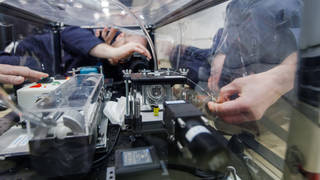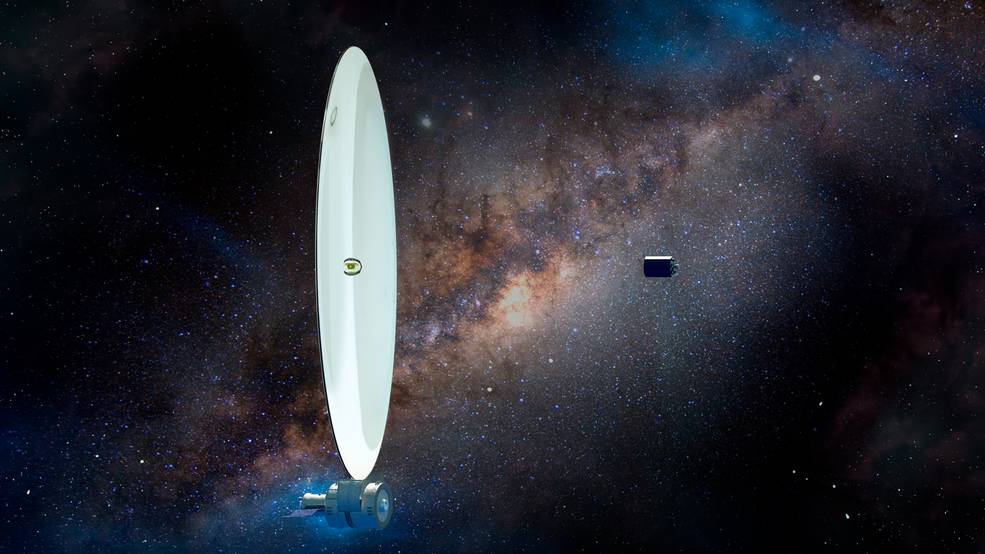upper space telescopes. Ten – or even a hundred – larger than it is today. Designed with liquid optics, nature made right in space. Lenses and mirrors made of liquid materials that have zero gravity Surface tension It gives a perfect spherical bend. The perfect surface for telescope optics. At the same time, overcoming the otherwise insurmountable limitations imposed by the space available in the nose cones for bombers.
Artist’s impression of the stages of a possible future giant telescope to be produced in space using liquids. Credits: Studio Ella Maru
Too good to be true? It does not seem so. A series of weightlessness tests last December, during two equivalent test flights, confirmed what the models had predicted. Now it’s up to the four crew members – specifically A Eitan Step – from Axiom 1 Special Missionsince last Saturday aboard the space station, conducted further tests in microgravity.
All liquids are subject to surface tension, a force that holds particles together on the outside of the liquid. Which allows some insects to walk on the surface of the pond without sinking, for example, which gives the water droplets their shape. Here on Earth, when water droplets are less than 2 mm in size, the surface tension exceeds gravity, making them perfectly spherical. However, the larger the droplet, the more it ends up being deformed by its own weight. This does not happen in space, where in the absence of weight, even the largest drops, after the settling phase, end up taking a perfect spherical shape.
So perfect that the team leads him Edward BalabanAnd Principal Investigator from the flexible telescope experimentthe flute) of NASA Ames Research Center — a team that also includes researchers from Goddard Space Flight Center, also of NASA, and the Israeli Institute of Technion Technology — decided to investigate the possibility of creating high-performance lenses and mirrors. Precision directly in space using fluids.
“We thought, ‘Why not take advantage of the way fluids naturally behave in microgravity and apply it to building large-scale telescopes, or multipurpose optical components produced in space?” Balaban says. “In microgravity, fluids take shapes that are useful for making lenses and mirrors, so if we make them directly in space, they can be used to build much larger telescopes than previously thought.”

Flute researchers acquire data while injecting synthetic oil into a circular frame (the size of a coin), to temporarily form a liquid lens, during the 15-20 second microgravity period in an equivalent ZeroG flight. Credits: Technion – Israel Institute of Technology
To test the hypothesis, some preliminary tests were conducted here on Earth first, by immersing liquids in other liquids of the same density, to simulate weightlessness. “By injecting liquid into circular shapes immersed in water that can then be solidified, we were able to make lenses out of a floor-washing bucket, literally,” explains the researcher who developed this method. Valerie Frumkinfrom the Technion. The choice of materials in which the lenses are made falls naturally on polymers, such as those also used in beauty salons to create acrylic artificial nails, or Types of glue Excellent gum“.
“This method allows us to completely skip any mechanical process, such as grinding or polishing,” he adds. Moran Berkowice, also from the Technion. “Simply put, natural fluid physics is doing all the work for us.” calendar? Lenses with surfaces of exceptional quality, comparable to or even better than those obtained with the finest polishing methods, made in a fraction of the time required by conventional processes.
In subsequent tests, those performed during parabolic flights, the fluid used – injected into a coin-sized ring – was synthetic oil, similar to motor oil, and to quickly and accurately measure the curvature a laser was used. “Exactly as expected, within seconds we were able to make a self-supporting liquid lens, until the plane rose again and gravity thrust inward, causing the oil to escape,” Bercovici recalls.
For the experiment on the space station, liquid polymers will be used again, so that they can be treated – by polymerization with UV or heat – in order to keep them in their acquired form. This will allow us to accurately study the optics obtained in the laboratory, once they are returned to Earth. “We expect this approach to result in smooth, perfectly shaped surfaces – perfect surfaces are converted into mirrors,” he says. Vivek DwivediAl Goddard’s Flute Project Scientist and Technical Expert at deposition of atomic layers Which can be used to make ultra-high-resolution telescope mirrors directly into space.
“If our experiment at the station is successful, it will be the first time an optical component has been built in space,” Balaban concludes. “It’s like making history.”

“Internet trailblazer. Travelaholic. Passionate social media evangelist. Tv advocate.”







More Stories
Long tenures for general managers
NASA's Psyche space probe communicates via laser with Earth from a distance of 226 million kilometers
A possible explanation for one of cosmology's greatest mysteries has arrived